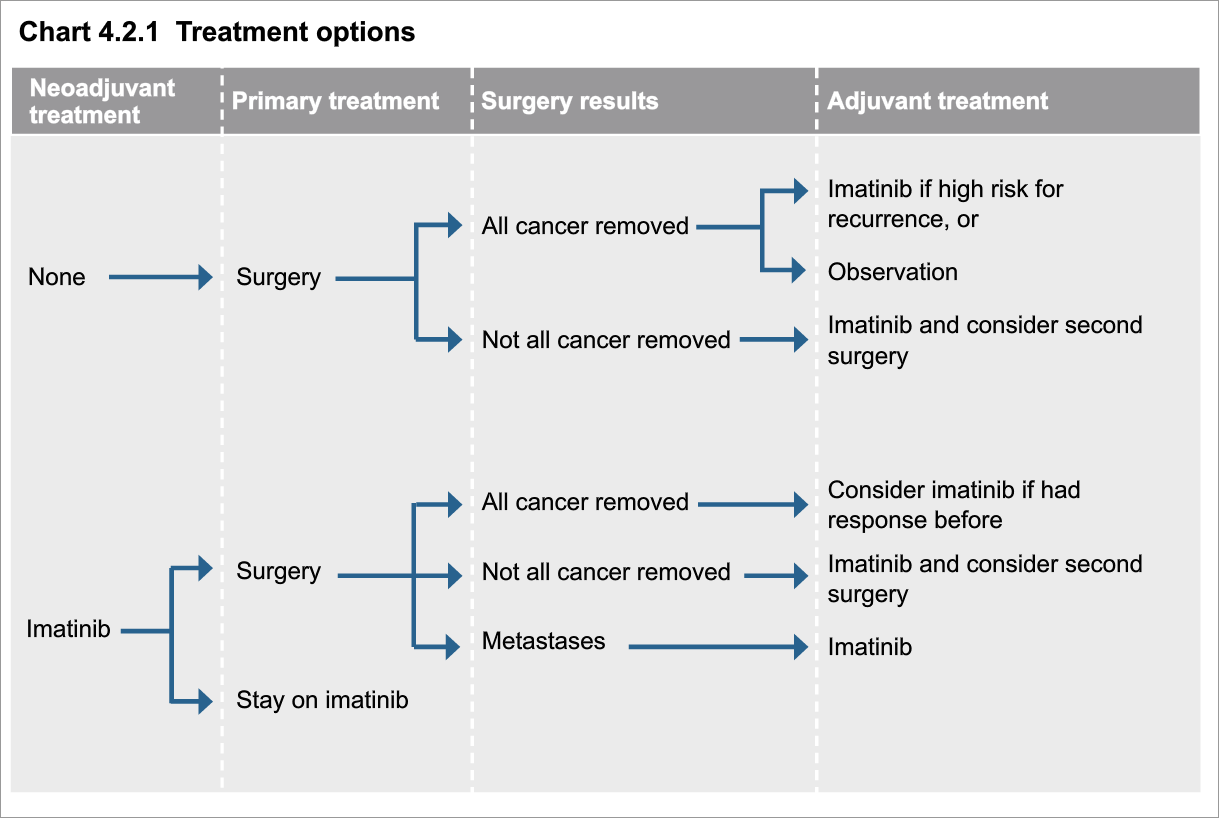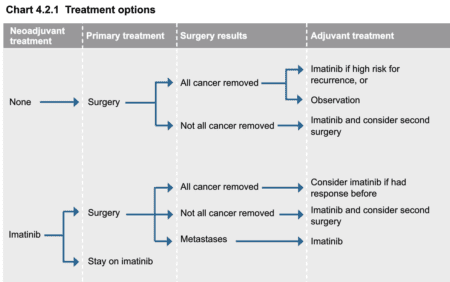Your Gastrointestinal stromal tumor prognosis images are ready in this website. Gastrointestinal stromal tumor prognosis are a topic that is being searched for and liked by netizens today. You can Download the Gastrointestinal stromal tumor prognosis files here. Find and Download all royalty-free photos.
If you’re searching for gastrointestinal stromal tumor prognosis images information connected with to the gastrointestinal stromal tumor prognosis interest, you have come to the ideal blog. Our website always provides you with hints for viewing the highest quality video and picture content, please kindly surf and find more informative video content and images that fit your interests.
Gastrointestinal Stromal Tumor Prognosis. Gastrointestinal stromal tumors GISTs span a wide spectrum of malignant potential. Molecular biomarkers for prognosis of gastrointestinal stromal tumor. These tumors derived from Cajal cells or their precursors most commonly occur at the age 50 years in the stomach 60 jejunum and. A pathologist makes a diagnosis of GIST by looking at the shape and appearance of tumor cells doing tests for a protein called KIT and other tumor markers and finding the mitotic count a way of measuring how many cells are actively dividing.
 Nccn Task Force Report Update On The Management Of Patients With Gastrointestinal Stromal Tumors In Journal Of The National Comprehensive Cancer Network Volume 8 Issue Suppl 2 2010 From jnccn.org
Nccn Task Force Report Update On The Management Of Patients With Gastrointestinal Stromal Tumors In Journal Of The National Comprehensive Cancer Network Volume 8 Issue Suppl 2 2010 From jnccn.org
Gastrointestinal stromal tumors GISTs are potentially malignancies that can occur anywhere in the digestive tract. The tumors tend to appear in the stomach or. See Stages for more information. When a GIST is surgically removed resected both physicians and patients want to predict whether the surgery was curative versus the alternative that GIST will reappear later. Molecular biomarkers for prognosis of gastrointestinal stromal tumor. This retrospective study included 451 patients who underwent.
A gastrointestinal stromal tumor GIST is a rare type of cancer that occurs in the gastrointestinal GI tract.
When a GIST is surgically removed resected both physicians and patients want to predict whether the surgery was curative versus the alternative that GIST will reappear later. The staging for GISTs ranges from Stage I through Stage IV and generally follows the American Joint Committee on Cancers TNM system. Lack of reproducible diagnostic criteria led to previous classification of such tumors as leiomyomas leiomyoblastomas and leiomyosarcomas avoiding accurate actual use based on older published work of GI sarcoma surgical. Gastrointestinal GI stromal tumors GISTs are the most common mesenchymal tumors specific to the GI tract generally defined as KIT CD117-positive tumors with a characteristic set of histologic features. Most gastrointestinal stromal tumors GISTs develop within the wall of the stomach or small intestine and might not cause symptoms early on. Molecular biomarkers for prognosis of gastrointestinal stromal tumor.
 Source: scirp.org
Source: scirp.org
A pathologist makes a diagnosis of GIST by looking at the shape and appearance of tumor cells doing tests for a protein called KIT and other tumor markers and finding the mitotic count a way of measuring how many cells are actively dividing. The staging for GISTs ranges from Stage I through Stage IV and generally follows the American Joint Committee on Cancers TNM system. Being sick vomiting fatigue tiredness and a feeling of weakness a high temperature fever and sweating at. GIST was thought to originate from interstitial cells of Cajal ICC a pace-maker cell that regulated gut peristalsis. However the prognosis of GISTs is still poor and more than half of GIST patients suffer from recurrence within 5 years of curative surgery 1 2.
 Source: researchgate.net
Source: researchgate.net
A pathologist makes a diagnosis of GIST by looking at the shape and appearance of tumor cells doing tests for a protein called KIT and other tumor markers and finding the mitotic count a way of measuring how many cells are actively dividing. Gastrointestinal stromal tumors GISTs are potentially malignancies that can occur anywhere in the digestive tract. However most patients with localized GISTs may have no specific physical exam findings as some tumors present without symptoms and extra-abdominal metastases are rare. Some tumors grow large enough to block the passage of food through the stomach or intestine. Genetic factors can increase the risk of having a gastrointestinal stromal tumor.
 Source: surgery.ucsf.edu
Source: surgery.ucsf.edu
The prognosis of patients with gastrointestinal stromal tumors GISTs is generally evaluated at the time of diagnosis but does not reflect the survival dynamics of patients in the future. Gastrointestinal stromal tumors GISTs are potentially malignancies that can occur anywhere in the digestive tract. These tumors derived from Cajal cells or their precursors most commonly occur at the age 50 years in the stomach 60 jejunum and ileum. Because GISTs are often fragile they can sometimes rupture which can lead to a hole perforation in the wall of the GI tract. Symptoms related to blood.

Most gastrointestinal stromal tumors GISTs develop within the wall of the stomach or small intestine and might not cause symptoms early on. Gastrointestinal stromal tumors GISTs are the most common mesenchymal neoplasm in the gastrointestinal tract. A pathologist makes a diagnosis of GIST by looking at the shape and appearance of tumor cells doing tests for a protein called KIT and other tumor markers and finding the mitotic count a way of measuring how many cells are actively dividing. Molecular testing of the tumor. A gastrointestinal stromal tumor GIST is a rare type of cancer that occurs in the gastrointestinal GI tract.
 Source: liferaftgroup.org
Source: liferaftgroup.org
Gastrointestinal GI stromal tumors GISTs are the most common mesenchymal tumors specific to the GI tract generally defined as KIT CD117-positive tumors with a characteristic set of histologic features. Gastrointestinal stromal tumors GISTs are potentially malignancies that can occur anywhere in the digestive tract. Gastrointestinal stromal tumors GISTs are the most common mesenchymal neoplasm in the gastrointestinal tract. Most gastrointestinal stromal tumors GISTs develop within the wall of the stomach or small intestine and might not cause symptoms early on. When a GIST is surgically removed resected both physicians and patients want to predict whether the surgery was curative versus the alternative that GIST will reappear later.
 Source: liferaftgroup.org
Source: liferaftgroup.org
Gastrointestinal stromal tumors GISTs span a wide spectrum of malignant potential. Lack of reproducible diagnostic criteria led to previous classification of such tumors as leiomyomas leiomyoblastomas and leiomyosarcomas avoiding accurate actual use based on older published work of GI sarcoma surgical. Because GISTs are often fragile they can sometimes rupture which can lead to a hole perforation in the wall of the GI tract. T stands for tumor size. Therefore the purpose of this article was to evaluate the conditional survival CS of Chinese patients with GISTs after radical resection.
 Source: researchgate.net
Source: researchgate.net
Gastrointestinal stromal tumor GIST is the most common mesenchymal tumor of the gastrointestinal tract. These tumors derived from Cajal cells or their precursors most commonly occur at the age 50 years in the stomach 60 jejunum and ileum. Some tumors grow large enough to block the passage of food through the stomach or intestine. Discomfort or pain in the tummy abdomen blood in your poo stools or vomit. Therefore the purpose of this article was to evaluate the conditional survival CS of Chinese patients with GISTs after radical resection.
 Source: nature.com
Source: nature.com
Gastrointestinal GI stromal tumors GISTs are the most common mesenchymal tumors specific to the GI tract generally defined as KIT CD117-positive tumors with a characteristic set of histologic features. Surgical resection is the primary treatment for resectable GISTs. Tyrosine kinase inhibitors TKIs such as imatinib have proven effective since the discovery of KIT and PDGFRA. Lack of reproducible diagnostic criteria led to previous classification of such tumors as leiomyomas leiomyoblastomas and leiomyosarcomas avoiding accurate actual use based on older published work of GI sarcoma surgical. Gastrointestinal stromal tumor GIST is the most common of the mesenchymal tumors accounting for up to 3 of malignant tumors of the gastrointestinal tract GI.
 Source: researchgate.net
Source: researchgate.net
Molecular testing of the tumor. This is called an obstruction and it can cause severe abdominal pain and vomiting. Molecular testing of the tumor. Because GISTs are often fragile they can sometimes rupture which can lead to a hole perforation in the wall of the GI tract. Being sick vomiting fatigue tiredness and a feeling of weakness a high temperature fever and sweating at.
 Source: researchgate.net
Source: researchgate.net
However the prognosis of GISTs is still poor and more than half of GIST patients suffer from recurrence within 5 years of curative surgery 1 2. Molecular testing of the tumor. This retrospective study included 451 patients who underwent. Being sick vomiting fatigue tiredness and a feeling of weakness a high temperature fever and sweating at. Signs of acute abdomen or peritonitis may indicate the presence of GI bleeding tumor rupture bowel perforation or GI obstruction.
 Source: semanticscholar.org
Source: semanticscholar.org
The staging for GISTs ranges from Stage I through Stage IV and generally follows the American Joint Committee on Cancers TNM system. Signs of gastrointestinal stromal tumors include blood in the stool or vomit. Most gastrointestinal stromal tumors GISTs develop within the wall of the stomach or small intestine and might not cause symptoms early on. However the prognosis of GISTs is still poor and more than half of GIST patients suffer from recurrence within 5 years of curative surgery 1 2. Genetic factors can increase the risk of having a gastrointestinal stromal tumor.
 Source: annalsofoncology.org
Source: annalsofoncology.org
These tumors derived from Cajal cells or their precursors most commonly occur at the age 50 years in the stomach 60 jejunum and ileum. Gastrointestinal stromal tumor GIST is the most common mesenchymal tumor of the gastrointestinal tract accounting for nearly 13 of all malignant gastrointestinal tumors. We discussed the clinical-pathological. These tumors derived from Cajal cells or their precursors most commonly occur at the age 50 years in the stomach 60 jejunum and. Being sick vomiting fatigue tiredness and a feeling of weakness a high temperature fever and sweating at.
 Source: researchgate.net
Source: researchgate.net
This retrospective study included 451 patients who underwent. The staging for GISTs ranges from Stage I through Stage IV and generally follows the American Joint Committee on Cancers TNM system. Gastrointestinal stromal tumor is a disease in which abnormal cells form in the tissues of the gastrointestinal tract. When symptoms of gastrointestinal stromal tumors occur they may include. Gastrointestinal stromal tumors GISTs start in very early forms of special cells in the wall of the GI tract called the interstitial cells of Cajal ICCs.
 Source: researchgate.net
Source: researchgate.net
Gastrointestinal stromal tumors GISTs span a wide spectrum of malignant potential. Therefore the purpose of this article was to evaluate the conditional survival CS of Chinese patients with GISTs after radical resection. GIST was thought to originate from interstitial cells of Cajal ICC a pace-maker cell that regulated gut peristalsis. Gastrointestinal stromal tumor GIST is submucosal neoplasm that is thought to be of Cajal cell origin 15 16. Most gastrointestinal stromal tumors GISTs develop within the wall of the stomach or small intestine and might not cause symptoms early on.
 Source: researchgate.net
Source: researchgate.net
Several factors influence the prognosis of gastrointestinal stromal tumors GISTs but the primary prognostic factors include the tumor staging and the tumor resectability. Molecular testing of the tumor. Some tumors grow large enough to block the passage of food through the stomach or intestine. When a GIST is surgically removed resected both physicians and patients want to predict whether the surgery was curative versus the alternative that GIST will reappear later. This is called an obstruction and it can cause severe abdominal pain and vomiting.
 Source: liferaftgroup.org
Source: liferaftgroup.org
Common clinical signs in dogs with GIST include lethargy anorexia and diarrhea and abdominal distension due to tumors can be also observed 2 15. We discussed the clinical-pathological. Some tumors grow large enough to block the passage of food through the stomach or intestine. These tumors derived from Cajal cells or their precursors most commonly occur at the age 50 years in the stomach 60 jejunum and ileum. When symptoms of gastrointestinal stromal tumors occur they may include.
 Source: researchgate.net
Source: researchgate.net
We discussed the clinical-pathological. Gastrointestinal stromal tumors GISTs span a wide spectrum of malignant potential. The prognosis of patients with gastrointestinal stromal tumors GISTs is generally evaluated at the time of diagnosis but does not reflect the survival dynamics of patients in the future. Surgical resection is the primary treatment for resectable GISTs. Molecular testing of the tumor.
 Source: jnccn.org
Source: jnccn.org
Gastrointestinal stromal tumors GISTs start in very early forms of special cells in the wall of the GI tract called the interstitial cells of Cajal ICCs. However the development of molecular markers especially circulating biomarkers remains largely undone for the prognosis of GIST. Surgical resection is the primary treatment for resectable GISTs. Most gastrointestinal stromal tumors GISTs develop within the wall of the stomach or small intestine and might not cause symptoms early on. These tumors derived from Cajal cells or their precursors most commonly occur at the age 50 years in the stomach 60 jejunum and.
This site is an open community for users to share their favorite wallpapers on the internet, all images or pictures in this website are for personal wallpaper use only, it is stricly prohibited to use this wallpaper for commercial purposes, if you are the author and find this image is shared without your permission, please kindly raise a DMCA report to Us.
If you find this site helpful, please support us by sharing this posts to your own social media accounts like Facebook, Instagram and so on or you can also save this blog page with the title gastrointestinal stromal tumor prognosis by using Ctrl + D for devices a laptop with a Windows operating system or Command + D for laptops with an Apple operating system. If you use a smartphone, you can also use the drawer menu of the browser you are using. Whether it’s a Windows, Mac, iOS or Android operating system, you will still be able to bookmark this website.





